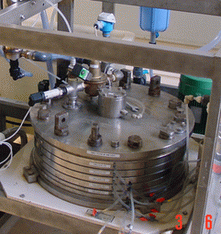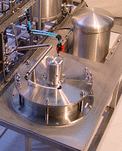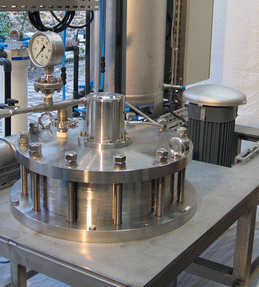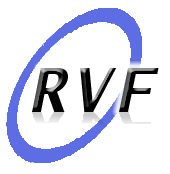
RVF – dynamic membrane filtration in the nonstationary flux
RVF (rotating-vibrating filtration) is designed for filtration of highly concentrated liquids characterized with high fouling and/or clogging characteristics. It uses disc-shaped flat sheet membranes in the vicinity of the rotating bodies. These rotating bodies as well as the pulsating blows generate highly dynamic vortex movements of filtered liquid being in contact with the membrane surface resulting in high values of shear rates thus preventing any particles or molecules to accumulate on the surface of the membrane or to enter inside the pores. Flow rate through the pores remains stable and being at a high level even with highly concentrated liquids to be filtered.
The innovation lies in the possibility to extend the use of membrane filtration with more and more concentrated and viscous liquids with highly fouling characteristics (silt density index, SDI) such as liquid industrial wastes, fermentation broth (rough beer), natural extracts, etc.
Apparatus (Fig. 1) contains a number of the filtration cells stacked around the shaft, each of them is composed of the following parts:
i. porous backing plate draining the permeate to the periphery of the cell;
ii. membranes arranged onto the two faces of that porous backing plate (Fig. 2);
iii. rotating bodies arranged in the immediate vicinity of the des membranes and driven to the rotation by that shaft (Fig. 3).
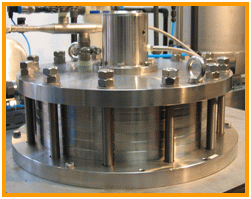


Fig. 1. Fig. 2. Fig. 3.
The liquid to be treated is introduced into the apparatus and driven to the rotation by the said bodies (Fig. 3 - rose color arrows). The resultant movement of that liquid is the combination of the tangential component as well as vortex and pulsating ones. Under the effect of a pressure difference said liquid is separated by the membrane on the permeate (filtrated part: Fig. 3 - blue color arrows ) and the retentate (concentrated part: Fig. 3 - dark red color arrows). Membranes and backing plates remain stationnary.
**Patent nn°: FR2771305, US6613231, EP1044061, ...
Main parameters of the liquids that can be treated with RVF
- Viscosity up to 800 cP
- Very clogging liquids can be treated: high values of TSS, DS, COD, concentration of high molecular organic matters
- This technology requires only very slight prefiltration upstream NF and RO: SDI index of the waste water to be treated can be very high (> 20 or even non-measurable ones)
Area of the developed RVF filtration plants
- Model series of the RVF filtration plants:
- Plants operating at low pressure: MF & UF processes;
- Plants operating at high pressure: NF & RO processes;
- Application range of the RVF filtration plants:
- Plnts for food industry: MF & UF processes;
- Plnts for pharmaceutical industry: MF & UF processes;
- Plnts for environmental protection industry (industrial WWTPs): NF & RO processes;
Main operating parameters of the RVF filtration plants
- Maximum pressure reached to date is 55 bar
- Average linear velocity of the concentrate in the vicinity of membrane's surface: 6-15 m/s;
- Power consumption of the plant used for:
- MF & UF processes: 4-8 kWh/m3
- NF & RO processes: 20-40 kWh/m3
- High recoveries can be reached
- Permeate flow rate is 1.5-8 times higher compared to the classical cross-flow filtration
- Very low pressure drop in the filter and concequently very low circulation pump's power required
- Can be charged with organic membranes, stainless steel or metal-ceramic ones.
- Long cycles of operation between cleanings result in:
- increased production capacity of the plant
- economy of the reagents and the energy for CIPs
- preservation the environment by lowering the volume of waste waters produced
- The rejection and the permeability of the membrane stays stable due to low fouling
- Ability of the plant to be adapted to the client's verying requirements by means of:
- Adding or removing the membrane disks
- Changing the type of the used membranes
